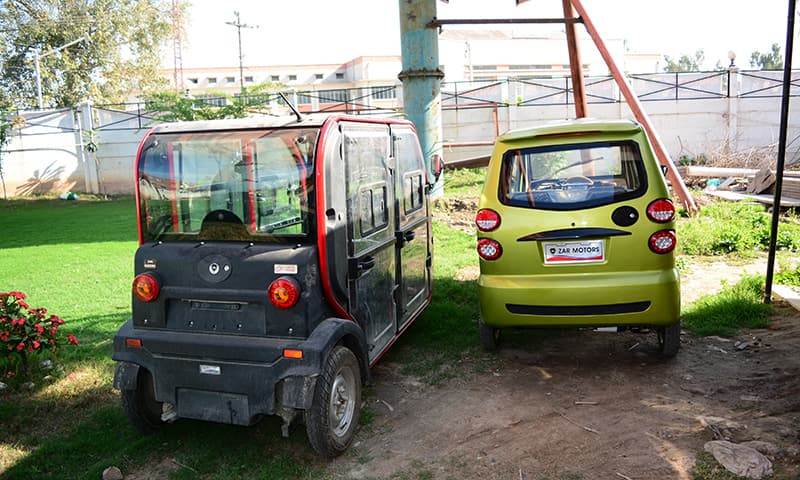PESHAWAR: Electric rickshaws are easy and fun to drive. They are smaller, featuring a cleaner design, with a power electrical motor enabling fast acceleration. It also ensures that the vehicle does not emit noise, smoke, or any hazardous gases.
These innovative rickshaws— also called E-Rickshaws— are the environmentally-friendly tri-wheeler solution for Khyber Pakhtunkhwa's meandering roads. Their sleek bodies and pollution-free trails will be a welcome change to roads teeming with noisy, smoke-emitting auto-rickshaws. Once approved by KP's transport department, they will hit the streets of Peshawar, and eventually, to the rest of the province.

Also read: Footprints: The pink rickshaw driving force
The sixth most polluted city in the world
The World Health Organisation's (WHO) 2011 report ranked Peshawar the sixth most polluted city in the world. According to the Environment Protection Agency (EPA), the average noise pollution (17 particles er million), far exceeds the permissible 9 PPM. In some spots, it is as much as 38 PPM.
Similarly, Peshawar's noise level is always above WHO’s limit of 85 decibels, confirms Pir Muhammad Zubair, who manages the provincial transport department's Vehicular Emission Testing Station (VETS).
Experts at the Environmental Protection Agency (EPA) are concerned about the dangerous pollution levels. They blame the run-down vehicles plying on Peshawar's streets, which emit poisonous gases like nitrogen oxide, carbon dioxide, sulphur dioxide, smoke and hydrocarbons into the air, rendering it unfit for human consumption.
“The emission of air pollutants is directly related to consumption of petroleum products,” Zubair explains. Road transport, which relies on fuel, is responsible for 47.2 per cent of the country's total petroleum products, both locally-produced and imported.
However, while all vehicles consume fuel and pollute the air, tri-wheelers—with their jarring thuk-thuk sounds and high gas emissions—are particularly harmful to the environment.
Too many rickshaws
"Most tri-wheelers run on two-stroke engines, which significantly contribute to air pollution,” explains Badar Zaman, vice president of the rickshaw union in Peshawar. “However, no one has taken action against this problem."
According to Regional Transport Authority Secretary Naimatullah, there are around 13,000 registered rickshaws in Peshawar, but the actual number is much higher. “We do not have the exact number of unregistered rickshaws,” Naimatullah says. He believes there are more than 50,000 registered and unregistered rickshaws in the city.
VETS has examined over 28,000 vehicles for gas emissions and noise production in 2014 and 2015, Zubair says. "Of these, over 7000 vehicles failed the tests," he remarks.

Read next: Lahore — a city of gardens, now a city of concrete
In developing countries, vehicles are routinely replaced or upgraded, but the average vehicle in Pakistan is over 15 years old. Zubair explains why this is another problem: "Older vehicles emit 20 times as many hydrocarbons as an average vehicle," he says. "They also emit 25 times more carbon monoxide, and 3.6 times more nitro oxides."
On the streets, this means that rickshaws routinely leave behind poisonous blankets of smoke, without realising the damage they are doing to their environment.
Enter the e-rickshaw
With no petrol, CNG and mobile-oil requirements, electric rickshaws need minimum maintenance. The E-rickshaw, which is assembled in China and Japan and then imported to Pakistan, can accommodate three to four people and can go as fast as 40 to 45 kilometers per hour. With increasing incidents of gas cylinder blasts in rickshaws, e-rickshaws are safe for travelling.
While the transport department has tested and approved the vehicles, confirming that the E-Rickshaw functions smoothly even in rain, rickshaw-drivers are a bit skeptical. "We are poor people," one driver says. "What will we do with the old rickshaws? If the government helps us out in this matter, we will welcome these vehicles."
Currently, a driver with a permit in Peshawar can buy an auto-rickshaw for as little as Rs300,000. Compared to this, the E-Rickshaw will be significantly more cost-efficient. It is estimated to launch at a cost of Rs240,000 for a new rickshaw.
How it works

For charging, the E-Rickshaw requires any normal outlet (100V-240V), similar to the ones used for charging cell-phones. The battery can be charged upto 80 per cent in two hours, while a full charge takes seven hours.
“It saves fuel and CNG, and is more economical than the regular rickshaw,” says Ali, the examiner of motor vehicles at the transport department. The vehicle has been developed keeping low cost in mind— aside from the fact that it comes with zero carbon emissions, because of its low maintenance fee, it can be driven in both rural and urban areas.
An E-Rickshaw charged at 80pc battery, for example, can be driven for 50km. "Free special route permits will be issued to electric rickshaws for one year," adds Ali, explaining how the government is planning to launch two prototypes: the mini-cab, and the loader.


The mini-cab comes with comfortable driving and passenger seats, and includes a luggage compartment and crystal light. It can carry five passengers comfortably at a time, and runs for 150km on a single charge. The battery comes with a 14-month warranty.
The loader, which charges quicker, comes with a driving seat and a passenger seat, and an open luggage compartment at the back. Although people can pile into the compartment, the loader is likely to be used for transporting goods and animals. Its battery comes with a 18-month warranty,
An official at the transport department who tested the e-rickshaw says it rolled silently on the streets. "People were making videos from their cell phones," he recalls, "They are not used to seeing a tri-wheeler car on the road."













































